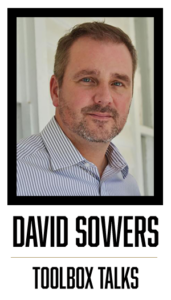Years ago, our company was brought in by a large, industrial client (we’ll call them ABC) to help them improve their safety culture. ABC had been around for decades and was continually growing. However, this growth brought with it some challenges: ABC was producing, but its safety numbers were declining. They had recently suffered a significant safety event and this became their catalyst for wanting change.
 Without going into too much detail (because this isn’t a case study), ABC had a fire in its belly and started taking steps to change its safety culture—and it worked. The company improved its safety numbers across the board. The tide had turned, and victory was declared. When we exited, we left ABC with some actions to preserve its gains and prevent its team from losing momentum. Our most important advice was for them to put in the work every day. “Improvement is a journey, not a destination. Keep doing the day-to-day work to keep improving.”
Without going into too much detail (because this isn’t a case study), ABC had a fire in its belly and started taking steps to change its safety culture—and it worked. The company improved its safety numbers across the board. The tide had turned, and victory was declared. When we exited, we left ABC with some actions to preserve its gains and prevent its team from losing momentum. Our most important advice was for them to put in the work every day. “Improvement is a journey, not a destination. Keep doing the day-to-day work to keep improving.”
The company quickly returned to business as usual. For decades, it had never paid attention to its safety culture until forced to do so. Once the company wasn’t required to face it anymore, it didn’t. The pain of the significant safety event had faded, and the improved safety numbers brought a sense of “all is well.” The team had some turnover in leadership and eventually, putting in the work to shape the safety culture became less of a priority. The return to the old safety culture was almost inevitable and certainly predictable. We have all seen what happens when the fire fades.
This scenario reminded me of something I had heard in church.
One Sunday my youth group was asked, “Who do you think tends to build the stronger testimony? The person who comes to church after a ‘near-death’ experience or the person who is looking to learn about a better way?” I thought the person with the “near-death” experience was certainly more motivated than the casual knowledge-seeker. This person has a fire and a passion, a deep and personal experience, to keep their determination high. Like most teenagers, my confidence in my answer had no impact on its accuracy.
This is (roughly) how it was explained to me (it’s been a few years).
The person with the “near-death” experience typically comes to the table with emotions high and one, broad goal: “I need to get right!” Over time, the emotions fade, and they start to rationalize why things might not have been so dire after all. They are in a better place and quickly think they have done enough to understand what it means to be better. They have reached their destination and stop putting in the work. They stop improving and start to backslide.
The person who comes with the question “Is there a better way?” isn’t trying to “fix” one thing. They are looking for a holistic approach. They know this improvement journey requires continuous learning and the understanding that there is always room to grow. They find the ideas that are valuable to them and use them to change their behaviors a little at a time. They aren’t seeking big changes; they seek small, daily growth. They don’t stop putting in the work because they are measuring progress in two ways: how close they are to a destination AND how far they are from the place they didn’t want to be. Chasing perfection is a frustrating and unattainable goal, but continuous improvement is rewarded every day.
Improvement is a journey, not a destination.
“I need to get right!” is a destination.
Toolbox Talks offers quick insights and thoughts to use for your toolbox (tailboard) talks. Dave Sowers is a founding member of Knowledge Vine, a veteran-owned human performance training and consulting organization that strives to reduce the frequency and severity of human errors in the workplace. He has almost 30 years of experience in power generation and the utility industry. He is a veteran of U.S. Navy Nuclear Power Program and holds a bachelor’s degree in resources management and a master’s degree in both management and emergency management and homeland security.



